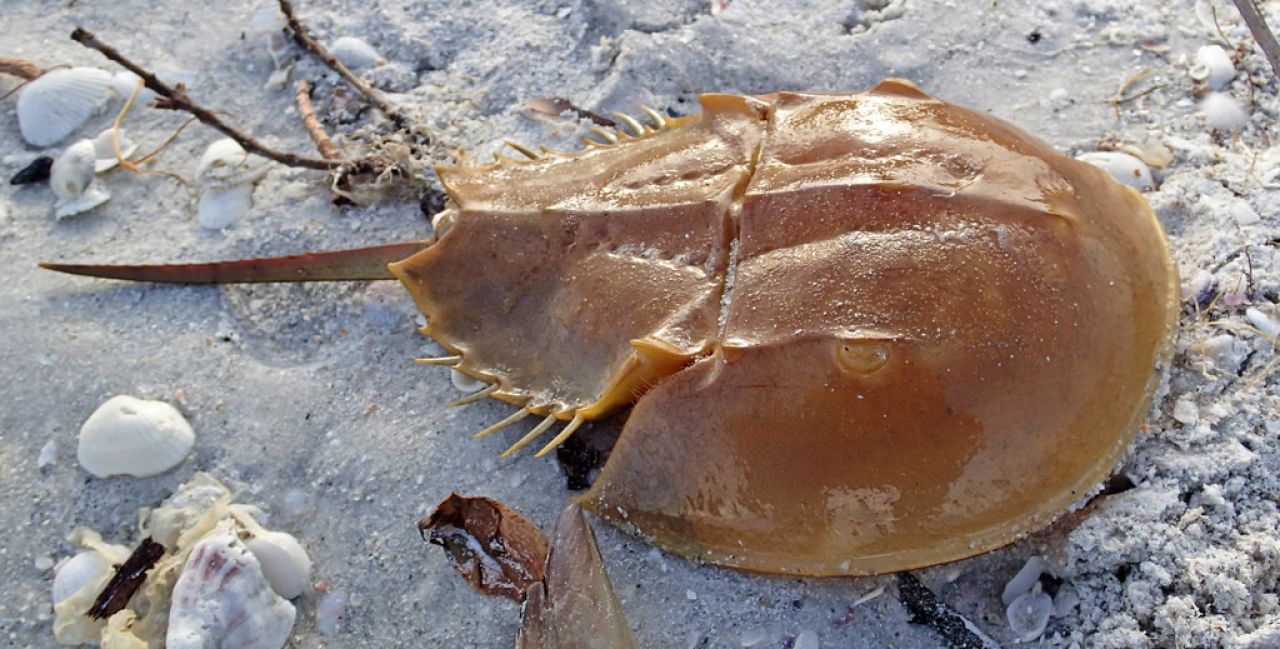Appearance and lifestyle:
The Atlantic horseshoe crab (Limulus polyphemus) has a hard carapace that looks like a horseshoe which protects the crabs inside. They have ten legs and a pointed tail; they can grow up to 60cm long.
The Atlantic horseshoe crab is an important prey animal for loggerhead sea turtles, while their eggs are commonly eaten by seabirds. Traditionally, their eggs were also eaten by Native Americans. The horseshoe crab poses no threat to humans. Its long, scorpion-like tail contains no sting – it is used for balance and for pushing sand aside.
Habitat:
The Atlantic horseshoe crab lives in the shallow waters of the north-western Atlantic Ocean and the Gulf of Mexico, and in brackish coastal lagoons, where it can reach lengths of up to 60cm. The horseshoe crab lives in shallow, soft-bottomed habitats, where it ploughs through the upper layers of sand and mud in search of food. It’s large shield-like shell and splayed rear legs allow it to effectively shovel sediment aside.
Diet:
It is a scavenger, feeding on molluscs, polychaete worms, seaweed and fish carcasses that it exposes while ploughing.
Threats:
Overharvesting, habitat loss, climate change etc.
Bright blue blood
The blood of the horseshoe crab is blue and has the unusual quality of clotting very rapidly when exposed to certain bacterial toxins in incredibly small doses thanks to a chemical called coagulan. Coagulan is used for testing the sterilization of pharmaceutical drugs, surgical equipment and vaccines. Every FDA approved drug in the US must be tested this way. It has even been used to keep the International Space Station sterile.
Unfortunately for horseshoe crabs, no synthetic method of producing coagulan has been developed, resulting in more than a quarter of a million crabs being harvested each year. To curb population decline, new methods are used that only take 30% of the crab's blood, allowing them to be released alive, although with a significantly diminished chance of survival.
Ancient ocean dwellers
Despite its name, the horseshoe crab is not a crab at all. It is a Chelicerate, the same phylum as spiders, ticks, mites, scorpions and the extinct sea scorpion. Today’s horseshoe crabs are the last in the ancient Xiphosuran order – a group closely related to the now-extinct trilobite. The first horseshoe crab evolved more than half a billion years ago, but they have changed very little in the last 300 million years. The Atlantic horseshoe crab is one of only four species of horseshoe crabs alive today. The other species are the mangrove horseshoe crab from Southeast Asia, the Indo-Pacific horseshoe crab ranging from India to Indonesia and the Chinese horseshoe crab.
Larvae: Ancestral look-alikes
During the breeding season, the horseshoe crab migrates to the tidal zone to lay eggs. Approximately 200 to 300 eggs are laid in a series of shallow depressions excavated in the beach sand. The male fertilises the eggs as they are being laid by the female. These eggs hatch into so-called “trilobite larvae” – so named because of their superficial resemblance to their ancient relative. Initially, about 1cm long, a larva can swim and burrow in the sand. As it grows, it undergoes a series of moults, becoming progressively more like its parents.
